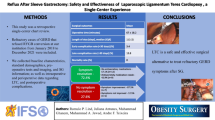Abstract
Background and Aims
UK guidelines recommend that patients with gallstone pancreatitis have cholecystectomy within 2 weeks of their pancreatitis. A proportion of these are elderly with significant comorbidities rendering them high risk for general anaesthesia and surgery. Endoscopic retrograde cholangiopancreatography (ERCP) and endoscopic sphincterotomy (ES) may offer a safe alternative to cholecystectomy as definitive treatment in these patients.
Patients and Methods
A retrospective review of all cases of gallstone pancreatitis presenting between 1999 and 2009 was undertaken.
Results
One hundred one patients underwent ERCP and ES as a definitive treatment for gallstone pancreatitis with a median age of 78 years (range, 43–96 years) and a median American Society of Anesthesiologists grade of 2. Three patients died from pancreatitis despite successful ERCP. Eighty-nine patients were successfully treated with an ERCP alone, and 84 patients (94%) had no recurrence of pancreatitis with a mean follow-up of 41 months (±32 months, range 4–118 months). The total patient follow-up was 3,260 months. Twenty-seven patients (33%) died within the follow-up period of unrelated causes, explaining the lower than expected median follow-up. Five patients had a recurrence of pancreatitis during follow-up (6%).
Conclusion
ERCP with ES is a safe alternative to laparoscopic cholecystectomy to prevent further attacks of gallstone pancreatitis in high-risk surgical patients and the elderly.


Similar content being viewed by others
References
Yadav D and Lowenfels A. Trends in the epidemiology of the first attack of pancreatitis: A systematic review. Pancreas. 2006; 33(4):323–330.
Opie EL. The aetiology of acute haemorrhagic pancreatitis. Bulletin of John Hopkins Hospital. 1901; 12:182–8.
Acosta J, and Ledesma C. Gallstone migration as a cause of acute pancreatitis. New England Journal of medicine. 1974; 290:484–7.
Kelly TR. Gallstone pancreatitis: pathophysiology. Surgery. 1976; 80:488–92.
Kelly TR. Gallstone pancreatitis: The timing of surgery. Surgery. 1980; 88:345–9.
Armstrong C, Taylor T, Jeacock J, and Lucas S. The biliary tract in patients with acute gallstone pancreatitis. British Journal of Surgery. 1985; 72:551–555.
Acosta J, Rubio Galli O, Rossi R, Chinellato A, and Pellegrini C. Effect of duration of ampullary gallstone obstruction on severity of lesion of acute pancreatitis. Journal of the American College of Surgeons. 1997; 184:499–504
Neoptolemos JP, Carr-Locke DL, London NJ et al. Controlled trial of urgent endoscopic retrograde cholangiopancreatography and endoscopic sphincterotomy versus conservative treatment for acute pancreatitis secondary to gallstones. Lancet. 1988; 2:979–83
Fan ST, Lai EC, Mok FP et al. Early treatment of acute biliary pancreatitis by endoscopic papillotomy. New England Journal of Medicine. 1993; 328:228–232.
Sanjay P, Yeeting S, Whigham C et al. Endoscopic sphincterotomy and interval cholecystectomy are reasonable alternatives to index cholecystectomy in severe acute gallstone pancreatitis. Surgical Endoscopy. 2008; 22:1832–1837.
Hammarstrom LE, Stridbeck H and Ihse I. Effect of endoscopic sphincterotomy and interval cholecystectomy on late outcome after gallstone pancreatitis. British Journal of Surgery. 1998; 85:333–336.
UK guideline for the management of acute pancreatitis. UK working party on acute pancreatitis. Gut. 2005; 54(suppl III): iii1–iii9
Vazquez-Lglesias J, Gonzalez-Conde B, Lopez-Roses L et al. Endoscopic sphincterotomy for prevention of the recurrence of acute biliary pancreatitis in patients with gallbladder in situ. Long-term follow-up of 88 patients. Surgical Endoscopy. 2004; 18:1442–1446
Welbourn C, Beckly D and Eyre-Brook I. Endoscopic sphincterotomy without cholecystectomy for gallstone pancreatitis. Gut. 1995; 37:119–120
Lee J, Ryu J, Park J, et al. Roles of endoscopic sphincterotomy and cholecystectomy in acute biliary pancreatitis. Hepatogastroenterology. 2008; 55:1981–1985
Johnson A and Hosking S. Appraisal of the management of bile duct stones. British Journal of Surgery. 1987; 74:555–560.
Andriulli A, Loperfido S, Napolitano G et al. Incidence rates of post-ERCP complications: A systematic survey of prospective studies. American journal of Gastroenterology. 2007; 102:1781–1788.
Salminen P, Laine S and Gullichsen R. Severe and fatal complications after ERCP: Analysis of 2555 procedures in a single experienced center. Surgical Endoscopy. 2008; 22:1965–1970.
Data from Norfolk County Council. http://www.norfolkinsight.org.uk/population.asp. Accessed Jan 2011
Targarona E, Ayuso R, Bordas J et al. Randomised trial of endoscopic sphincterotomy with gallbladder left in situ verus open surgery for common bile duct calculi in high-risk patients. The Lancet. 1996; 347:926–29
Boerma D, Rauws E, Keulemans C et al. Wait-and-see policy or laparoscopic cholecystectomy after endoscopic sphincterotomy for bile-duct stones: a randomised trial. The Lancet. 2002; 360:761–65
Zacks S, Sandler R, Rutledge R et al. A population-based cohort study comparing laparoscopic cholecystectomy and open cholecystectomy. American Journal of Gastroenterology. 2002; 97:334–40
McMahon A, Fischbacher C, Frame S, et al. Impact of laparoscopic cholecystectomy: A population-based study. Lancet 2000; 356:1632–37
A prospective analysis of 1518 laparoscopic cholecystectomies. The Southern Surgeons Club. New England Journal of Medicine. 1991; 324:1073–1078
Sandzen B, Haapamaki M, Nilsson E et al. Cholecystectomy and sphincterotomy in patients with mild acute biliary pancreatitis in Sweden 1988 – 2003: a nationwide register study. BMC Gastroenterology. 2009; 9:80–86.
Brunt L, Quasebarth D, Dunnegan et al. Outcome analysis of laparoscopic cholecystectomy in the extremely elderly. Surgical Endoscopy. 2001; 15:700–705
Hazzan D, Geron N, Golijanin D et al. Laparoscopic cholecystectomy in octogenarians. Surgical Endoscopy. 2003; 17:773–776
Gloor B, Stahel P, Muller et al. Incidence and management of biliary pancreatitis in cholecystectomized patients. Results of a 7-year study. Journal of Gastrointestinal Surgery. 2003; 7:372–7.
Conflicts of interest
None of the authors have any conflict of interests or disclosures to make.
Author information
Authors and Affiliations
Corresponding author
Rights and permissions
About this article
Cite this article
Bignell, M., Dearing, M., Hindmarsh, A. et al. ERCP and Endoscopic Sphincterotomy (ES): A Safe and Definitive Management of Gallstone Pancreatitis with the Gallbladder Left In Situ. J Gastrointest Surg 15, 2205–2210 (2011). https://doi.org/10.1007/s11605-011-1729-x
Received:
Accepted:
Published:
Issue Date:
DOI: https://doi.org/10.1007/s11605-011-1729-x




